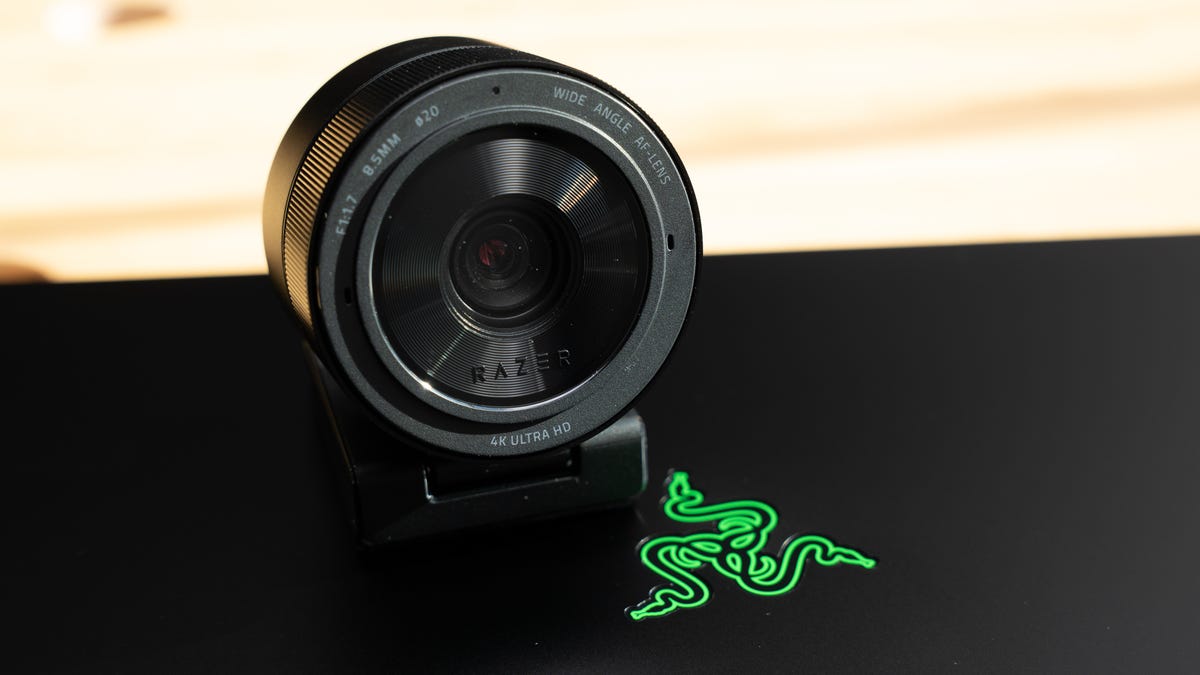My initial reaction to the Razer Kiyo Pro Ultra’s video was “Wow! Finally a webcam as good as a compact vlogging camera.” My reaction after trying to adjust the settings, especially when using it with a third-party application, was “I’m going to reach through my screen and punch you now.” Seriously: Razer’s Synapse software is the only thing preventing this $300 ( 300, AU$500) 4K webcam for streamers and power videoconferencers from getting an Editors’ Choice award.
It noticeably raises the quality above Razer’s Kiyo Pro — enough that the Kiyo Pro’s price has dropped significantly, and at $100 the Pro’s a great alternative if you just want a step up to solid 4K.
Synapse is the only way to control most of the settings, so it can make or break your experience. If you don’t need to change settings besides zoom, focus or white balance that often (they’re available via the Windows driver), then you’ll probably be OK. And even Synapse 3 doesn’t work on the Mac, so the webcam’s not well suited for that platform.
Like
- Excellent quality and performance
- Nice built-in lens cover design
- Has a relatively large number of adjustable settings which compensate for issues other cameras have
Don’t Like
- Synapse control of camera is glitchy and the camera occasionally hangs when changing settings
- You can only change settings when Synapse has exclusive control of the camera
The Kiyo Pro Ultra’s closest non-Razer competitor would have been the Elgato Facecam Pro, which no longer seems to be available anywhere despite shipping in November 2022. (It used a previous generation of the Sony Starvis sensor, and it’s always possible that it’s being reworked with the newer sensor.)
That camera supported 4K at 60fps compared to the Razer’s 30fps (at 1080p and lower it can do 60fps), but otherwise the Razer has a lot of the same strengths, including manual exposure controls, user presets and other settings which can help you tweak the quality of your output, such as MJPEG quality (for streaming at 1440p or 4K) and the ability to meter off your face in autoexposure mode (important if you’re off center) and lens distortion compensation.
While it looks similar to the rest of its Kiyo siblings, the Pro and the X (on our list of the best webcams we’ve tested), it has something I’ve wanted for a while: a built-in lens cover. Razer cleverly incorporated it as an iris that closes when you rotate the outer ring.
Top marks for quality and performance
When it’s good, the Kiyo Pro Ultra is great. It incorporates a 1/1.2-inch Sony Starvis 2 sensor, which is a just bit smaller than the 1-inch sensor in compact vlogging cameras like the Sony ZV-1 but loads bigger than the sensors in other webcams, with a good size f1.7 aperture.
The larger sensor and aperture means it shows perceptible depth-of-field blur. It doesn’t have as wide a field of view as many webcams, only up to 82 degrees (72 degrees with distortion correction on) rather than 90 or more, which could affect its suitability for your needs.


The Ultra displays excellent tonal range for what it is, though it falls short in handling bright areas. It needs some software tweaking for that, I think. It has the typical HDR option, but in a backlit shot with a properly exposed foreground (as well as without), it didn’t help clip the overbrightness in the back. There are toggles for both dark and light rooms, but neither seemed to make a perceptible difference. I’ve had other cameras handle it better.
It meters properly, for the most part. Center metering works best if you’re in the center — face metering overexposes oddly without tweaking the exposure compensation, otherwise. But if you lean to the side, face metering keeps it from spiking when it sees your black chair instead of your face. White balance is very good as long as you’re not in too dark an environment. Even then it’s not bad. Nor does it lose a lot of color saturation.
You can toggle a couple of noise reduction settings and they do make a significant difference in low light. The distortion compensation makes a visible difference as well.
Standard autofocus is meh, just like all the other webcams. But there are several settings to mitigate the frequent hunting, which other webcams don’t have. Face autofocus does a good job of keeping it from hunting when you move your head, and there’s a “stylized lighting” setting which helps the AF system lock when the lighting might otherwise confuse it.
The camera handles some of the image processing that might otherwise be sent to the PC, notably the MJPEG compression of the stream you’re sending, and you can set how aggressively it compresses either automatically or on a performance-to-quality continuum.
Still needs some baking
Unfortunately, it’s still just a little too glitchy and the software limits it unintentionally. You can’t access any of the settings in Synapse — most notably resolution/frame rate and manual exposure (ISO and shutter speed) — unless camera preview is enabled. And Windows only allows one application to access a camera at a time.
So, for example, if you’ve accidentally left the resolution at 4K but you need it to be 1080p in OBS, to change it you have to first deactivate the camera in OBS — thankfully, OBS has that option, but Nvidia Broadcast doesn’t. Then jump over to Synapse, turn on preview, change the resolution, turn off preview, jump back to OBS and reactivate the camera. And resolution, among other settings, doesn’t seem to be saved as part of the profiles you can create.
Doing it once isn’t that much of a problem. After the 10th time in an hour it gets old.
It’s also complicated by the occasional failure of settings to kick in, which sometimes forces you to loop back through that activate-deactivate cycle: Why does my adjusted exposure not look adjusted? Do I have to kick it to get autofocus to kick in? The preview in Synapse isn’t always accurate, though that’s not unique to Synapse, but it means you can’t assume your adjustments there will be correct. Synapse also froze several times while I was trying to swap between profiles.
Almost every other reasonable webcam utility allows you to change settings while viewing within the application you need them for. Yes, sometimes a few are disabled (because Windows), but at least they’re not all unavailable. It’s possible that all these issues can be ameliorated with firmware and software patches, but I have learned never to assume that just because they can be that they will be.
The Razer Kiyo Pro Ultra is a capable webcam that just needs some software and firmware polish before I’m comfortable considering it a reliable, consistent performer.
The best laptops in every category
- Best Laptop for 2023
- Best Windows Laptops
- Best Laptop for College
- Best Laptop for High School Students
- Best Budget Laptop Under $500
- Best Dell Laptops
- Best 15-Inch Work and Gaming Laptops
- Best 2-in-1 Laptop
- Best HP Laptops
- Best Gaming Laptop
- Best Cheap Gaming Laptop Under $1,000
- Best Chromebook: 8 Chromebooks Starting at Under $300


